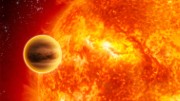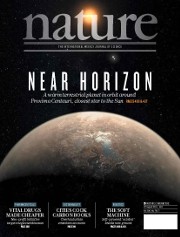
Many of us grew up knowing only the nine (now eight) planets of our Solar System. A few are lucky enough to remember the discovery of Pluto, then the 9th planet, by Clive Tombaugh in 1930. “See Another World In The Sky”, the newspapers proclaimed, “Achievement of Century”! Some 62 years later in human history, not one but two new planets were announced in Nature by two US-based astronomers, Aleksander Wolszczan and Dale Frail (Wolszczan & Frail 1992). These planets happened to be significantly further than Pluto, and indeed, not in our Solar System: 2,300 light years away, orbiting a millisecond pulsar at distances of roughly a third and a half that of the Earth’s around the Sun. These were the first two confirmed “extrasolar planets”, found in the uninhabitable regions around a neutron star.
 The discovery of a Jupiter-mass planet around a Sun-like star three years later cemented the foundation of this new study of “exoplanets”. Two researchers in Geneva, Michel Mayor and Didier Queloz, utilised a French telescope to observe the star 51 Pegasi (Mayor & Queloz 1995). Using a spectrograph, they noticed the slight shifts in the star’s spectral lines that indicated an orbiting body – a technique known as the radial velocity method. The planet, they determined, orbited at a distance significantly smaller than that of Mercury in our Solar System. The closing paragraph of their Letter to Nature satisfyingly proclaims the era that they had just been responsible for initiating: “The search for extrasolar planets can be amazingly rich in surprises. From a complete planetary system detected around a pulsar to the rather unexpected orbital parameters of 51 Peg b, searches begin to reveal the extraordinary diversity of possible planetary formation sites."
The discovery of a Jupiter-mass planet around a Sun-like star three years later cemented the foundation of this new study of “exoplanets”. Two researchers in Geneva, Michel Mayor and Didier Queloz, utilised a French telescope to observe the star 51 Pegasi (Mayor & Queloz 1995). Using a spectrograph, they noticed the slight shifts in the star’s spectral lines that indicated an orbiting body – a technique known as the radial velocity method. The planet, they determined, orbited at a distance significantly smaller than that of Mercury in our Solar System. The closing paragraph of their Letter to Nature satisfyingly proclaims the era that they had just been responsible for initiating: “The search for extrasolar planets can be amazingly rich in surprises. From a complete planetary system detected around a pulsar to the rather unexpected orbital parameters of 51 Peg b, searches begin to reveal the extraordinary diversity of possible planetary formation sites."
 To date over 3,500 exoplanets have been confirmed, and they are classified into groups under potentially misleading names like “Super-Earths” and “Hot Jupiters”. More and more detailed properties of exoplanets have been determined: in addition to the minimum mass (from the radial velocity method) and planetary radius (from when planets cross in front of the visible disk of their host star – the transit method), the surface temperature of exoplanets can be determined, the atmospheric composition, the presence of exomoons. Heather Knutson led a team to investigate the diurnal temperature changes of a hot Jupiter (Knutson et al. 2007), deriving day-side and night-side temperatures and constraining the energy transport properties of the atmosphere. Mark Swain, Gautam Vasisht and Giovanna Tinetti detected the first organic molecule, methane, in an exoplanetary atmosphere (Swain et al. 2008). Perhaps the most inspiring exoplanet detection to capture the interest of the general public was the discovery in 2016 of a terrestrial planet in a temperate orbit around our nearest stellar neighbour, Proxima Centauri, by Guillem Anglada-Escudé and colleagues (Anglada-Escudé et al. 2016).
To date over 3,500 exoplanets have been confirmed, and they are classified into groups under potentially misleading names like “Super-Earths” and “Hot Jupiters”. More and more detailed properties of exoplanets have been determined: in addition to the minimum mass (from the radial velocity method) and planetary radius (from when planets cross in front of the visible disk of their host star – the transit method), the surface temperature of exoplanets can be determined, the atmospheric composition, the presence of exomoons. Heather Knutson led a team to investigate the diurnal temperature changes of a hot Jupiter (Knutson et al. 2007), deriving day-side and night-side temperatures and constraining the energy transport properties of the atmosphere. Mark Swain, Gautam Vasisht and Giovanna Tinetti detected the first organic molecule, methane, in an exoplanetary atmosphere (Swain et al. 2008). Perhaps the most inspiring exoplanet detection to capture the interest of the general public was the discovery in 2016 of a terrestrial planet in a temperate orbit around our nearest stellar neighbour, Proxima Centauri, by Guillem Anglada-Escudé and colleagues (Anglada-Escudé et al. 2016).

